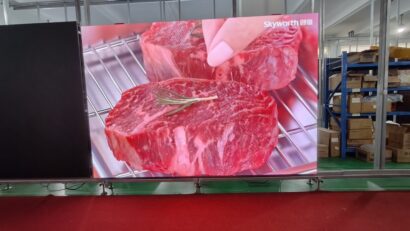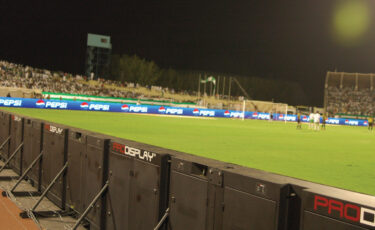LED DISPLAY SCREEN plays a very crucial role in our daily life. No matter where we go, we can see LED screens everywhere. The beautiful colors and the display contents both attract our eyes.
But, have you ever seen one LED display screen with distorted or stretched photos and videos displayed? Have you ever wondered what makes the image looks strange? This article of LEGIDATECH will give me the answer.

When we are going to choose LED screens, one of the main elements in determining the viewer experience is the “Aspect Ratio”.
Whether it is an indoor fixed screen or an outdoor advertising LED digital billboard, the aspect ratio can significantly impact the visual experience for audiences.
If we are going to use the wrong aspect ratio for the LED display screen, the displayed videos and pictures will look abnormal and distorted. This can negatively impact the viewing experience.
With the fast development of the LED technology, we could see all kinds of the LED display screens, among them are some creative led screens such as LED ball screens, cube led screens, flexible LED screens and so on.
And the screen sizes requirements from the clients are bigger and bigger, so how to choose the LED screen and make it display the photos and videos in the correct and comfortable way is very crucial.
We need to calculate and choose the best aspect ratio to make the LED screen gives the best viewing experience.
What is the aspect ratio of a screen?
The aspect ratio of a screen or image refers to the proportional relationship between its width and height.
In the case of 4:3, for every 4 units of width, there are 3 units of height. This was a standard aspect ratio for older televisions and computer monitors.
On the other hand, 16:9 is a wider aspect ratio, with 16 units of width for every 9 units of height.
This has become the standard for high-definition televisions, computer monitors, and most modern video content.
The main difference between the two is the width-to-height ratio, with 16:9 providing a wider and more panoramic view compared to the more square-like 4:3 aspect ratio.


How does aspect ratio influence the visual performance?
The aspect ratio will affect the viewings for the contents of the LED screen. Thus, every content should be designed with the best ratio in according to the LED screens.
By doing so, you will get the best aspect ratio of the LED display screen and achieve the ideal visual effect.
The aspect ratio decides on which screen you will display the content. Since every display screen has a different ratio, you will need to match it with the screen.
The content will appear distorted if the ratio does not fit our screen. With this explanation, you will understand why the aspect ratio is so crucial for the LED screens.
Before display the contents, we will need to optimize the aspect ratio of content.
4:3 aspect ratio is popular for some screen screens such as 4m x 3m LED screen for churches.
In some Africa countries, the church LED displays is more and more popular, and the pastors are worried about its quality and effect.
So they start from the size 4m x 3m, it is the best size to match the 4:3 aspect ratio. And it is good for display normal videos and pictures.

16:9 aspect ratio is the most commonly used aspect ratio. We can say that it is a standard ratio for TVs, computers, and display screens today. It offers a panoramic view.
You can see a vast image or content with this ratio. It is also common in cinemas. But we don’t often see this ratio in photography.
Sometimes, people use this to capture a broader image. Apart from this, it is popular in Film Studies and TVs.

If you display the 4:3 video on the 16:9 screen, black vertical boxes appear on either side. This phenomenon is ‘Pillar boxing or Reverse Letter boxing.’
Which aspect ratio is better, 16:9 and 4:3?
Sometimes, when we are talking with the clients about their projects, we will receive the question about which aspect ratio is better for their projects.
For this question, we need to check what is the aspect ratio of the contents will the clients going to display on the screens.
Without having the ideal aspect ratio, you could not get the best visual images of the screens. Thus, optimizing this ratio is very important. But which aspect ratio is perfect?
As we all know that 16:9 and 4:3 are the two most commonly aspect ratios globally.
We need to understand which one is best for your LED screens. Different ratios are ideal for different images or videos.
If we talk about the 4:3, it is for photography. High-resolution photos should have a 4:3 ratio. For videos, 16:9 is the most suitable.
The frame’s width is 78% more than its height. 16:9 is the most commonly used ratio in LED display screens.
Why are Aspect ratios important?
Aspect ratios are important because they determine the shape and size of the display. The aspect ratio of the image affects the way that the screen looks.
In addition, the aspect ratio of an image or display can also affect the way that it is captured, stored, or transmitted.
For example, certain aspect ratios may be more efficient for storing or transmitting images or video or may be more compatible with certain devices or software.
Overall, aspect ratios are an important consideration in the fields of photography, videography, and digital media, as they can impact the visual appearance and usability of images and displays.
What are some of the common aspect ratios?
There are several common aspect ratios that are widely used in photography, videography, and digital media:
- 4:3 – This aspect ratio is often used for standard definition video and images, and is also known as “full screen” or “academy ratio.”
- 16:9 – This aspect ratio is commonly used for widescreen videos and images, and is also known as “high definition” or “widescreen.”
- 3:2 – This aspect ratio is commonly used for traditional 35mm film cameras, and is also used by some digital cameras.
- 1:1 – This aspect ratio is often referred to as “square,” and is commonly used for images that will be displayed on social media platforms such as Instagram.
- 3:4 – This aspect ratio is the inverse of 4:3, and is sometimes used for portrait photography or for images that will be displayed vertically.
It’s important that you are using the best aspect ratio of your LED screen and the display images. By doing so, it can reach the best visual effect of your clients.
Author : Cathy Qin
FAQS:
- Why do LED screens have different aspect ratios?
A: Different Aspect ratios provide different viewing experiences. The aspect ratio chose should depend on the content you are displaying.
- What is the standard aspect ratio for most televisions and computer monitors?
A: The standard aspect ratio for most televisions and computers now is 16:9.
- For different pixel pitches LED display screen, with 16:9 aspect ratio and needs to reach 1080P definition, what is the size should for the LED screens:
A: P2.5mm 16:9 aspect ratio/1080P Screen Size :4.8m x 2.72m
P3mm 16:9 aspect ratio/1080P Screen Size :5.76m x 3.264m
P4mm 16:9 aspect ratio/1080P Screen Size :7.68m x 4.352m
P5mm 16:9 aspect ratio/1080P Screen Size :9.6m x 5.44m
- For fine pitches LED display screen, with 16:9 aspect ratio and needs to reach 4K definition, what is the size should for the LED screens:
A: P1.2mm 16:9 aspect ratio/4K Screen Size :4.8m x 2.7m
P1.5mm 16:9 aspect ratio/4K Screen Size :6m x 3.6m
P1.8mm 16:9 aspect ratio/4K Screen Size :7.2m x 4.32m
P2mm 16:9 aspect ratio/4K Screen Size :7.68m x 4.32m




